H 138 - Epirus (uncertain mint) (Epirote League), silver, drachms (234-168 BCE)
From SILVER
234 BCE - 168 BCE Silver 21,209 kg
Description
| ObverseInscription or printing placed on the obverse.: | Head of Zeus of Dodona to right, wearing wreath of oak leaves. |
| ReverseInscription or printing placed on the reverse.: | AΠEIPΩTAN (Greek).Eagle with closed wings standing right on thunderbolt, all within oak wreath. |
Mint and issuing power
| MintIdentifies the place of manufacture or issue of a numismatic object.: | Epirus (uncertain mint) | Ancient regionAncient region.: | Epirus | Modern countryModern country: Greece | AuthorityIdentifies the issuing power. The authority can be "pretended" when the name or the portrait of X is on the coin but he/she was not the issuing power. It can also be "uncertain" when there is no mention of X on the coin but he/she was the issuing power according to the historical sources: | Epirote League |
Chronology
| FromIdentifies the initial date in a range assigned in a numismatic context. | 234 BCE | toIdentifies the final date in a range assigned in a numismatic context.. | 168 BCE | PeriodTime period of the numismatic object.: Hellenistic 323-30 BC |
Physical description
| MetalThe physical material (usually metal) from which an object is made.: | Silver |
Median weightMedian of the weights of numismatic objects (in grams). in grams | 5.00 | DenominationTerm indicating the value of a numismatic object. Examples: tetradrachm, chalkous, denarius.: | drachma |
StandardStandard.: |
Image

H138 Zeus Dodona eagle.jpeg [1]
References
| Die study referencePublication of the study: | Franke 19611Franke 1961 | ||
| Coin series referenceReference to coin series study: | Sear I2Sear I, n° 1996, RQEMH3RQEMH, n° 138 | ||
Obverse dies distribution
| FrequencyFrequency of specimen in distribution. ᵖ | Number of obversesNumber of obverse dies. ᵖ (o) | % (o) | Number of coinsNumber of coins. (n) | % (n) | Die nameName(s) of the die(s). |
| 1 | 73 | 46.79 | 73 | 17.89 | 11, 12, 14, 18, 19, 20, 25, 27, 29, 31, 32, 33, 34, 37, 38, 40, 41, 42, 43, 44, 45, 46, 49, 52, 53, 54, 55, 57, 59, 63, 64, 65, 66, 68, 71, 72, 73, 76, 78, 80, 82, 83, 91, 93, 94, 95, 98, 100, 103, 106, 107, 109, 113, 115, 119, 121, 122, 125, 127, 132, 134, 138, 141, 145, 146, 153, 154, 156, 157, 160, 163, 164, 165 |
| 2 | 29 | 18.59 | 58 | 14.22 | 16, 17, 24, 26, 39, 50, 58, 60, 61, 74, 79, 81, 92, 101, 114, 116, 118, 120, 123, 124, 129, 137, 139, 140, 142, 143, 147, 161, 166 |
| 3 | 16 | 10.26 | 48 | 11.76 | 13, 28, 51, 62, 69, 70, 77, 84, 87, 88, 90, 96, 133, 136, 150, 152 |
| 4 | 15 | 9.62 | 60 | 14.71 | 21, 22, 23, 30, 35, 36, 99, 102, 104, 108, 111, 126, 155, 158, 159 |
| 5 | 5 | 3.21 | 25 | 6.13 | 67, 86, 105, 112, 117 |
| 6 | 9 | 5.77 | 54 | 13.24 | 47, 48, 75, 85, 97, 131, 144, 149, 162 |
| 7 | 3 | 1.92 | 21 | 5.15 | 128, 130, 151 |
| 8 | 2 | 1.28 | 16 | 3.92 | 56, 89 |
| 10 | 1 | 0.64 | 10 | 2.45 | 110 |
| 14 | 2 | 1.28 | 28 | 6.86 | 135, 148 |
| 15 | 1 | 0.64 | 15 | 3.68 | 15 |
| Total | 156 of 156 | 100 | 408 of 408 | 100.01 |
Reverse dies distribution
no distribution is available
Quantification
| Number of obversesNumber of obverse dies. ᵖ (o) | 156 | Number of singletons (o1)The number of singleton coins. ᵖ | 73 |
| Number of reverse diesNumber of reverse dies. (r) | 236 | Number of coinsNumber of coins. (n) | 408 |
| Coins per obverse dieNumber of coins per obverse die. (n/o) | 2.62 | Coins per reverse dieNumber of coins per reverse die. (n/r) | 1.73 |
| Reverse per obverse ratioRatio of obverse dies divided by reverse dies. (r/o) | 1.51 | Percentage of singletons (o1)number of coins (n) divided by the number of singletons (o1) ᵖ | 46.79 % |
| Original number of dies (O) (Carter 1983 formula)The estimation of the number of coins according to Carter 1983 ᵖ | 212.09 | Coins struck if 20,000 as average productivity per dieCoins made if the average productivity for obverses (according to Carter) is 20,000. ᵖ | 4,241,800 |
| Original number of dies (O) (Esty 2011 formula)The estimation of the number of coins according to the singleton formula in Esty 2011 ᵖ (O) | 252.57 | Survival rate if 20,000 as average productivity per dieSurvival rate if average productivity is 20,000. ᵖ | 0.00010 |
| Coverage (o = % of O) (Esty 1984 formula)Esty 1984 - coverage (% of O) ᵖ (o = % of O) | 82.11% | Die productivity if survival rate 1/2,000Average productivity if survival rate is 1/2,000. ᵖ | 3,847.42 |
| Weight of silver (in kg) if 20,000 coins per die (O = Carter formula)Carter 1983 * Median weight * 20000 (*10 if gold or electrum) ᵖ | 21,209 kg <br /> 21,209 kg | Die productivity if survival rate 1/5,000Average productivity if survival rate is 1/5,000. ᵖ | 9,618.56 |
Remarks